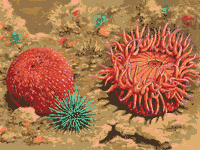Here are sea anemones, which live in the ocean or the sea. The sea anemone near the left of this picture is taking a snooze. He is resting or sleeping. The other one is not. He is waving his tentacles around hunting for food.
 At the end of each and every one of the sea anemone’s tentacles is a small capsule. Inside the capsule is a poisonous dart, attached to a sack of poison. Near the bottom of the dart is a spring system (kind of like a slinky). At the top of the capsule is a trap door complete with a trigger.
At the end of each and every one of the sea anemone’s tentacles is a small capsule. Inside the capsule is a poisonous dart, attached to a sack of poison. Near the bottom of the dart is a spring system (kind of like a slinky). At the top of the capsule is a trap door complete with a trigger. 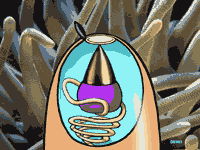 When a fish gets too close to the sea anemone’s tentacles and brushes the trigger, the trap door flies open, the poison dart shoots out, and the fish is injected with poison. The spring that launched the dart holds on until the poison takes effect. Now if it is a small fish, the poison will kill it; if it is a large fish, the poison will paralyze it or put it to sleep. In any case……That is lunch!
When a fish gets too close to the sea anemone’s tentacles and brushes the trigger, the trap door flies open, the poison dart shoots out, and the fish is injected with poison. The spring that launched the dart holds on until the poison takes effect. Now if it is a small fish, the poison will kill it; if it is a large fish, the poison will paralyze it or put it to sleep. In any case……That is lunch!
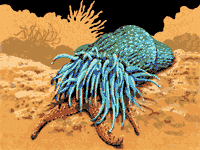 Here we see the anemone eating a starfish that got too close. Look once again at the sea anemones’s defense mechanism……Does that look like something that happened by chance and accident? Or does that look like something that was created by design?
Here we see the anemone eating a starfish that got too close. Look once again at the sea anemones’s defense mechanism……Does that look like something that happened by chance and accident? Or does that look like something that was created by design?
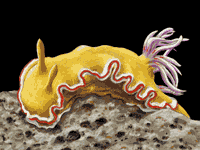 Here is another creature that also lives in the sea: a sea slug. Just as with dogs, we find a lot of variation in kinds of sea slugs. There are thousands of different sea slugs. Many sea slugs are brightly colored. These bright colors possibly warn other fish that the sea slug is poisonous. He might be advertising that it would be unhealthy for him to be eaten…. unhealthy for the other fish, and for the sea slug too. Girls, would this sea slug look good in your hair to wear as a barrette on Sunday morning?
Here is another creature that also lives in the sea: a sea slug. Just as with dogs, we find a lot of variation in kinds of sea slugs. There are thousands of different sea slugs. Many sea slugs are brightly colored. These bright colors possibly warn other fish that the sea slug is poisonous. He might be advertising that it would be unhealthy for him to be eaten…. unhealthy for the other fish, and for the sea slug too. Girls, would this sea slug look good in your hair to wear as a barrette on Sunday morning?
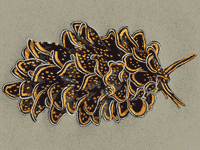 Or how about wearing this one? You may think that you are looking at a number of Monarch butterflies all clustered together, but it is not. What you are looking at is one sea slug. Could he be using the same colors as the Monarch, which is poisonous, to warn other creatures that he does not taste good?
Or how about wearing this one? You may think that you are looking at a number of Monarch butterflies all clustered together, but it is not. What you are looking at is one sea slug. Could he be using the same colors as the Monarch, which is poisonous, to warn other creatures that he does not taste good?
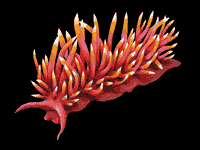 Another name for a sea slug is Nudibranch. When studying the nudibranchs, especially this next one, we should realize that they had to have been created, and that they never could have evolved. This sea slug is not brightly colored. He has no poison of his own, but what he can do is truly amazing. This nudibranch can sneak up on that sea anemone we just studied, rear up, and pounce right on top of him.
Another name for a sea slug is Nudibranch. When studying the nudibranchs, especially this next one, we should realize that they had to have been created, and that they never could have evolved. This sea slug is not brightly colored. He has no poison of his own, but what he can do is truly amazing. This nudibranch can sneak up on that sea anemone we just studied, rear up, and pounce right on top of him.
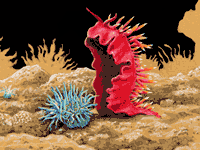 Then the sea slug eats the sea anemone whole, poison darts and all! For some reason the poison does not affect the sea slug, and the poison darts do not open up or fire; they just stay closed. The sea anemone is eaten and goes into the stomach of the sea slug, where it is digested, all except the poison darts, which stay in the belly of the sea slug, undigested! Now it really gets interesting. You will notice that the sea slug has tentacles, or what looks like arms or spines.
Then the sea slug eats the sea anemone whole, poison darts and all! For some reason the poison does not affect the sea slug, and the poison darts do not open up or fire; they just stay closed. The sea anemone is eaten and goes into the stomach of the sea slug, where it is digested, all except the poison darts, which stay in the belly of the sea slug, undigested! Now it really gets interesting. You will notice that the sea slug has tentacles, or what looks like arms or spines. 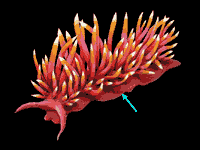 These spines are hollow inside8 (like a straw) and go right down into the stomach of the sea slug. Inside the arms or spines are what looks like tiny little hairs, called cilia. These cilia reach right down into the belly of the nudibranch, pick up the poison darts, wiggle and handoff the darts until they are carried to the tips of the sea slug’s tentacles where they are planted. Now something truly amazing happens. A fish or other predator sees the sea slug and says, “Wow that sure does look like a good meal.” As he goes to take a bite of the nudibranch, Pow! Pow! Pow! The poison darts fire! He has used someone else’s defense mechanism for his own! Did all this happen by chance and accident, or by intelligent design?
These spines are hollow inside8 (like a straw) and go right down into the stomach of the sea slug. Inside the arms or spines are what looks like tiny little hairs, called cilia. These cilia reach right down into the belly of the nudibranch, pick up the poison darts, wiggle and handoff the darts until they are carried to the tips of the sea slug’s tentacles where they are planted. Now something truly amazing happens. A fish or other predator sees the sea slug and says, “Wow that sure does look like a good meal.” As he goes to take a bite of the nudibranch, Pow! Pow! Pow! The poison darts fire! He has used someone else’s defense mechanism for his own! Did all this happen by chance and accident, or by intelligent design?
Consider, how many times did the sea slug have to die from the poison darts before he got it right? When we look at the sea slug, we realize that he could only have happened by design. Only God could have designed such a marvelous creature such as the sea slug. Even as smart as we are, or as smart as we think we are, man could never have come up with such a wonderful animal. Not only is our God a designer, He is Awesome!
See also: Sea Anemones, Sea Slugs, and an Amazing Missile System

